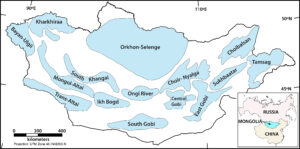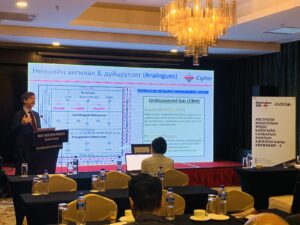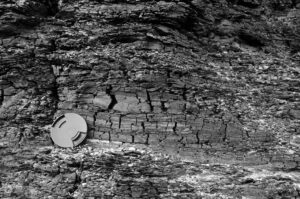Over the last seven months Cipher’s Experts have been working with Mongolian colleagues to assess the coalbed gas resources of Mongolia. The report was signed off just before the 30th of June, on time and to budget.
The Australian Mongolian Extractives Program (AMEP – phase 2)/Australian Aid funded the work and our
Mongolian team consisted of experts from the Mineral Resources and Petroleum Authority of Mongolia (MRPAM), National Geological Survey (NGS) of Mongolia and the National University of Mongolia. Specifically we’d like to thank Prof Erdentsogt, B. whose team identified most of the potential areas for assessment. Also, the management of project by Mendee Budee (AMEP) has been exceptional and we’d like to give our huge thanks to her careful guidance.
The Cipher team consisted of Dr Tim A Moore (geologist), Mike C. Friederich (geologist), Ryan D Morris (hydrogeologist) and Chris M. Nelson (gas specialist). Also Tianjiao Yu (Cipher Associate and QUT PhD student) provided crucial technical and research back up.
The philosophy behind area identification was to determine resources only in those areas where reliable data was obtainable within the logistical constraints of the program. With further work, application of subsurface and airborne geophysics is anticipated to increase these resource estimates. Both original gas in-place and undiscovered, unrisked Prospective Resources1 were determined, the latter of which has been assessed to be just over 7 trillion cubic meters (TCM) at the P50 level.
The report represents the first coalbed gas assessment concentrating solely on reservoirs away from immediate mining areas; estimates have been conducted using a probabilistic approach2. It anticipated the report would be made available to the public soon; each of the 80+ areas that have been assessed has the range of all the input variables delineated. The hope is that others will build on the knowledge of this report and modify and update data as more detailed assessments are made on individual areas.
More details about the workshop can be found here: https://www.amep.mn/news-detail/50. A brief description of the workshops is below along with links to the presentations (also found in the AMEP website).
“On June 15th and 16th, AMEP 2 with the Ministry of Mining and Heavy Industries (MMHI) and MRPAM held a two-day event focused on “Mongolia’s Coalbed Methane Prospects and Potential” that included a specialized one-day training on “Geology of Coalbed Methane, Prospecting, Reserve Classification and Assessment.” This two-day event aimed to bring together interested coalbed methane (CBM) professionals to share key information and perspectives on Mongolia’s newest commodities of interest and development. The two-day event saw over 100 participants representing professionals from the MRPAM, the National Geological Society (NGS), the Mongolian University of Science and Technology and more.
The first day focused on sharing key findings on CBM prospecting and potential in Mongolia, from identifying sector information changes, to accessing information, and to ensuring quality geo-science information. This work has been commenced and supported by AMEP 2 since 2019. As pointed out by AMEP 2 experts, namely
Dr. Tim Moore, Managing Director of Cipher Consulting and Adjunct Associate Professor of the Queensland University of Technology, Mr. Ryan Morris also of Cipher Consulting and RDMHydro, and Dr. Erdentsogt, B., the Dean of the Geology and Geophysics Department at the National University of Mongolia, CBM has key potential for downstream development and is an important transitional energy resource and an investment catalyst.
Experts discussed their use of the Petroleum Resources Management System (PRMS) methodology and its application as per international quality assurance standards. AMEP 2 Team Leader Rena Guenduez and leading experts conducted an open forum discussion amongst seminar participants on CBM cases from Australia and Mongolia, highlighting hydrogeology and water issues related to CBM resources, prospecting analysis’ goals, scope, classification, methods, results, and recommendations.
The second day session offered an advanced-level training for Mongolian geologists, researchers, and professors built on the previous day’s discussions, with a focus on the “Geology of Coalbed Methane, Prospecting, Reserve Classification, and Assessment.” Leading in the training was Dr. Tim Moore who informed participants on the origins of CBM, aspects of geological modeling of non-traditional oil reserves, mechanisms to measure, structure and collect CBM data according to international best practices and standards. Participants had ample time to engage in lively discussions and to network with other key experts within Mongolia and abroad to share experiences and information.
It is hoped that this event will further continue research on Mongolia’s CBM sector and to ignite investor interest as a transitional alternative towards green energy efficiency“.
You can download all the seminar and training PowerPoint presentations by clicking on each of the title link below.
June 15th Seminar Presentations:
1. Mongolia CBM Resources: Hydrogeology and Water. Presentation
2. CBM Resources of Mongolia: Goals, Scope, Classification. Presentation
3. CBM Resources of Mongolia: Methods, Results, Recommendations. Presentation
June 16th Advanced Training for CBM Geologists:
1. Origin of Reservoir: Peat to Pores. Presentation
2. Unconventional Hydrocarbons and Geological Models. Presentation.
3. Drilling Equipment Methods and Procedures. Presentation
4. Coal and Rock Review. Presentation
5. Gas Measurement. Presentation
6. Critical Reservoir Properties for CBM. Presentation
1As defined by the Society of Petroleum Engineers, 2018. Petroleum Resources Management System. Society of Petroleum Engineers, 57 pp.
2Crovelli, R.A., 2003. Probabilistic assessment methodology for continous-type petroleum accumulations. International Journal of Coal Geology 56, 45-48; Moore, T.A., Friederich, M.C., 2021. Defining uncertainty: Comparing resource/reserve classification systems for coal and coal seam gas. Energies 14, 6245, 35 pp., https://doi.org/10.3390/en14196245; Moore, T.A., Mares, T.E., Moore, C.R., 2009. Assessing uncertainty of coalbed methane resources, Proceedings, Indonesian Petroleum Association, 33rd Annual Convention & Exhibition. IPA09-G-056, 11 pp., Jakarta, Indonesia; Zuber, M.D., 1999. The use of Monte Carlo analysis to evaluate prospective coalbed methane properties, in: Mastalerz, M., Glikson, M., Golding, S.D. (Eds.), Coalbed Methane: Scientific, Environmental and Economic Evaluation. Kluwer Academic Publishers, Dordrecht, 55-66 pp.







Comments are closed.